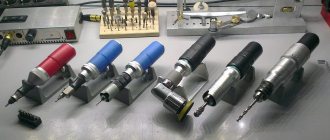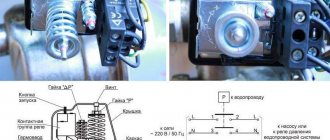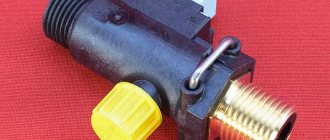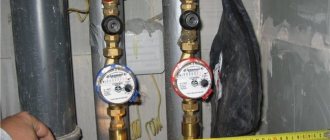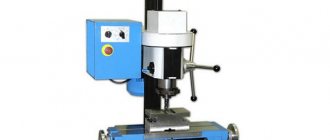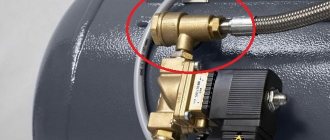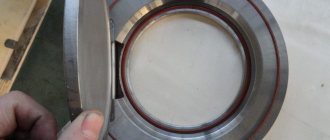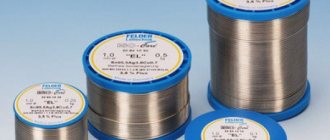Pressure gauges for measuring gas pressure: types, design features and operation of meters Often there is a need to measure the pressure created by gas. For example, in cylinders, in gas pipelines, in various containers and vessels. To control and monitor indicators, pressure gauges are used to measure gas pressure. These devices serve in various spheres of life, from medicine to heavy industry.
To ensure that the purchase of the device is not in vain, and that the purchased pressure gauge meets the requirements of production processes, it is worth familiarizing yourself with the classification. We will introduce you to the types of gas pressure meters. Let's talk about their design features and operating principles.
What is this device?
A pressure gauge is a device for measuring excess, that is, artificially created, pressure of water, steam or other working medium.
In simple terms, it shows how much greater the water pressure in the pipe is than atmospheric pressure.
In everyday life, in the housing and communal services sector and in industrial enterprises, the most common devices are those with a spring in the form of an oval tube (named after Bourdon, the man who patented it). They are simple in design and inexpensive.
Externally, a water pressure gauge is a round object in a metal or plastic case. The dial with the scale is covered with plexiglass made of methacrylate or polycarbonate.
Pressure gauges. Purpose and classification
Devices for measuring excess pressure are called manometers, vacuum (pressure below atmospheric) - vacuum gauges, excess pressure and vacuum - pressure and vacuum gauges, pressure difference (difference) - differential pressure gauges.
The main commercially produced devices for measuring pressure are divided into the following groups according to their operating principle:
— liquid — the measured pressure is balanced by the pressure of the liquid column;
— spring — the measured pressure is balanced by the force of elastic deformation of a tubular spring, membrane, bellows, etc.;
- piston - the measured pressure is balanced by the force acting on a piston of a certain cross-section.
Depending on the conditions of use and purpose, the industry produces the following types of pressure measuring devices:
— technical — general purpose instruments for equipment operation;
— control — for checking technical devices at the place of their installation;
- exemplary - for verification of control and technical instruments and measurements that require increased accuracy.
Spring pressure gauges
Purpose
. To measure excess pressure, pressure gauges are widely used, the operation of which is based on the use of the deformation of an elastic sensing element that occurs under the influence of the measured pressure. The value of this deformation is transmitted to the reading device of the measuring device, calibrated in units of pressure.
A single-turn tubular spring (Bourdon tube) is most often used as a sensing element of a pressure gauge. Other types of sensitive elements are: multi-turn tubular spring, flat corrugated membrane, harmonic-shaped membrane - bellows.
Device
. Pressure gauges with a single-turn tubular spring are widely used to measure excess pressure in the range of 0.6 - 1600 kgf/cm². The working body of such pressure gauges is a hollow tube of elliptical or oval cross-section, bent around the circumference by 270°.
The design of a pressure gauge with a single-turn tubular spring is shown in Figure 2.64. The tubular spring - 2 with its open end is rigidly connected to the holder - 6, mounted in the housing - 1 of the pressure gauge. The holder passes through a fitting - 7 with a thread that serves to connect to the gas pipeline in which the pressure is measured. The free end of the spring is closed with a plug with a hinged axis and sealed. By means of a leash - 5, it is connected to a transmission mechanism consisting of a gear sector - 4, coupled with a gear - 10, sitting motionless on the axis along with an indicator arrow - 3. Next to the gear there is a flat spiral spring (hair) - 9, one end of which connected to the gear, and the other is fixedly mounted on the rack. The hair constantly presses the tube to one side of the sector teeth, thereby eliminating backlash (play) in the gearing and ensuring smooth movement of the arrow.
Rice. 2.64. Indicating pressure gauge with single-turn tubular spring
Electric contact pressure gauges
Purpose.
Pressure gauges, vacuum gauges and electric contact pressure gauges of the type EKM EKV, EKMV and VE-16rb are designed for measuring, signaling or on-off control of pressure (discharge) of gases and liquids neutral in relation to brass and steel. Measuring instruments of the VE-16rb type are made in an explosion-proof housing and can be installed in fire-hazardous and explosive areas. The operating voltage of electrical contact devices is up to 380V AC or up to 220V DC.
Device
.The design of electric contact pressure gauges is similar to spring ones, with the only difference being that the pressure gauge body has large geometric dimensions due to the installation of contact groups. The structure and list of the main elements of electric contact pressure gauges are presented in Fig. 2.65..
The pressure gauges are exemplary.
Purpose. Model pressure gauges and vacuum gauges of the MO and VO type are intended for testing pressure gauges, vacuum gauges and pressure and vacuum gauges for measuring pressure and vacuum of non-aggressive liquids and gases in laboratory conditions.
Pressure gauges of the MKO type and vacuum gauges of the VKO type are designed to check the serviceability of working pressure gauges at the site of their installation and for control measurements of excess pressure and vacuum.
Rice. 2.65. Electric contact pressure gauges: a - EKM type; ECMV; EKV;
B - type VE - 16 Rb main parts: tubular spring; scale; mobile
Mechanism; group of moving contacts; inlet fitting
Electric pressure gauges
Purpose
. Electric pressure gauges of the DER type are designed to continuously convert excess or vacuum pressure into a unified AC output signal. These devices are used to work in conjunction with secondary differential transformer devices, centralized control machines and other information receivers capable of receiving a standard signal due to mutual inductance.
Device and principle of operation
. The principle of operation of the device, like that of pressure gauges with a single-turn tubular spring, is based on the use of deformation of the elastic sensing element when the measured pressure is applied to it. The structure of an electric pressure gauge of the DER type is shown in Fig. 2.65.(b). The elastic sensitive element of the device is a tubular spring - 1, which is mounted in a holder - 5. A bar - 6 is screwed to the holder, on which a coil - 7 of the differential transformer is attached. Constant and variable resistances are also mounted on the holder. The coil is covered with a screen. The measured pressure is supplied to the holder. The holder is attached to the housing - 2 screws - 4. The aluminum alloy housing is closed with a cover on which the plug connector is fixed - 3. The core - 8 of the differential transformer is connected to the movable end of the tubular spring with a special screw - 9. When pressure is applied to the device, the tubular spring is deformed , which causes a movement proportional to the measured pressure of the moving end of the spring and the associated differential transformer core.
Operational requirements for pressure gauges for technical purposes:
· when installing the pressure gauge, the tilt of the dial from the vertical should not exceed 15°;
· in the non-working position, the arrow of the measuring device must be in the zero position;
· the pressure gauge has been verified and has a stamp and seal indicating the verification date;
· there is no mechanical damage to the pressure gauge body, threaded part of the fitting, etc.;
· the digital scale is clearly visible to service personnel;
· when measuring the pressure of a moist gaseous medium (gas, air), the tube in front of the pressure gauge is made in the form of a loop in which the moisture condenses;
· a tap or valve must be installed at the point where the measured pressure is taken (in front of the pressure gauge);
· to seal the connection point of the pressure gauge fitting, gaskets made of leather, lead, annealed red copper, and fluoroplastic should be used. The use of tow and red lead is not allowed.
Why is it installed?
Measuring instruments are installed to monitor the state of the system . The pressure in the pipelines should not exceed a certain threshold value. At the same time, it must be sufficient to operate various devices.
To operate a shower with hydromassage, you need a pressure of 3-4 bar, a washing machine - about 0.5 bar, and a reverse osmosis filter - 2-6 bar.
Installation locations:
- pumping stations;
- boiler rooms;
- railway transport, automobiles, aircraft and water vessels;
- pressure pipelines;
- water heating devices;
- filtration systems.
Pressure gauges are purchased for personal use, in order, for example, to periodically monitor the pressure of the water entering the mixer.
They are permanently installed at pumping stations next to hydraulic accumulators and pressure switches to automatically turn the pump on and off. Often pressure gauges are part of automation units.
Pressure gauge device for measuring water pressure
A pressure gauge for measuring water pressure in a water supply system has a very simple design.
The device consists of a body and a scale on which the measured value is indicated. A tubular spring or a double-plate membrane can be located inside the housing. Also inside the device there is a holder, a tribco-sector mechanism and an elastic sensing element. The principle of operation of the device is based on balancing pressure indicators through the deformation force of a membrane or spring. As a result of this process, the elastic sensing element is displaced, which activates the indicating arrow of the device.
Operating principle
In a deformation (spring) pressure gauge, water enters a curved tube made of copper alloy. The water pressure causes the tube connected to the mechanism to deform, which causes the needle to turn.
Pressure gauges with a single-turn spring are designed for pressures up to 100 atm. To measure higher pressures, springs with several turns twisted into a spiral or screw are used.
There are devices in which a thin two-plate membrane is installed instead of a tube. They are suitable for viscous or contaminated solutions, withstand strong vibrations, but are sensitive to temperature fluctuations.
Metal pressure gauge
You have already seen the appearance of a metal pressure gauge in Figure 1. Let us now consider its internal structure, which comes in two main types. The first is shown in Figure 5.
Figure 5. Design of metal pressure gauge No. 1.
A curved hollow tube 1, sealed at one end, is connected on the other side to a tap 4, which communicates with the vessel in which the pressure needs to be measured.
As the pressure increases, tube 1 begins to unbend, and with the help of lever mechanism 5 and gears 3 transmits movement to pointer 2, which moves along the scale of the device.
Tube 1 is elastic, and when the pressure decreases, it returns to its original position, and the pointer returns to the zero scale division.
Figure 6 shows a slightly different type of metal pressure gauge.
Figure 6. Design of metal pressure gauge No. 2.
The difference in structure is only that the tube is sealed on both sides, but has an outlet for connection to the vessel in which the pressure needs to be measured. There are also two rods (levers) 2.
Note that, despite slight differences in the device (Figures 4 and 6), the principle of operation of metal pressure gauges remains the same.
The actual appearance of the metal pressure gauge is shown in Figure 7.
Figure 7. Realistic image of a metal pressure gauge.
What types are there?
List of main types of water pressure gauges:
- The most common are general technical spring pressure gauges for water, with a measurement range from 0 to 10 or from 0 to 6 atmospheres. The case diameter can be from 40 to 160 mm, most often 100.
- Boiler units – with a body diameter of 250 mm. They are needed to take instrument readings from a distance.
- Vibration-resistant pressure gauges - filled inside with a viscous liquid, in particular a glycerin solution or silicone oil. Measure pressure under conditions of strong vibrations. They are used at pumping stations, cars, compressors, trains.
- Corrosion-resistant pressure gauges – for working with chemically aggressive media.
- High-precision ones are needed for testing and crimping.
- Digital electronic - mechanical force is converted into an electrical signal. Readings are taken from the display, can be programmed, and some devices can be connected to a computer.
- Electrical contact (signaling) devices in which upper and lower pressure limits are set. If they are overcome, the electronic device is triggered and transmits a signal to the control device.
- Thermomanometers are devices that measure pressure and temperature in a heating or water supply system. On the front side there are two scales on which readings are taken.
For which pressure gauges are accuracy classes established?
All pressure gauges positioned as products that meet the standards of GOSTs and other quality regulations have class. exact Let us briefly list the types of devices.
The simplest mechanical pressure meter:
The most common group of DMs is mechanical, also known as deformation, analog.
Mechanical products can be tubular (with a tubular arch-spring, usually single-turn).
This arch is a so-called Bourdon tube, not quite a spring in the traditional sense, but a springy (elastic) arch. The bracket, through the articulation of the levers, at the end of which there is a toothed part, transmits the influence of the measured phenomenon to the pointer gear, moving it along the scale. The mechanism can be supplemented with a regular flat spring.
Strain gauges are also sometimes called "direct gauges".
Analogue DMs include membrane devices, where the main sensitive element is a membrane that responds to pressure. There are also bellows devices, they can be called an improved modification of the latter: the sensitive part is a corrugated (accordion-like) box (chamber), that is, a bellows.
Mechanics include liquid and deadweight pressure gauges. The former have a sensitive element - liquid in the flask, the latter have a special system of counterweights, piston joints.
Deadweight piston products are usually used as exemplary, reference devices:
A separate group of pressure gauges is electrical contact gauges (ECM); they can be mechanical or digital (the latter are usually always like this).
Mechanical ECMs are actually the same spring products, but they have electrical leads for transmitting data to associated control and other equipment.
The third large separate group of types of pressure gauges are digital or electronic. The sensitive elements here are special sensors or the same arc-shaped bow (bracket), spring, membrane, but the readings are interpreted by a microcircuit, which also displays them on the LCD display in numbers, like in calculators.
DMs are also divided into pointer ones and those with results displayed on an LCD display.
There are also the following types of pressure meters:
- exemplary (reference for verification, testing of other such devices);
- highly accurate. Typically these are electronic devices;
- axial, radial.
Below is an example of an exemplary mechanical pressure gauge (the scale is much expanded and, accordingly, especially accurate):
The division into types is not particularly significant for the issue under consideration; the presence of an error class does not depend on the type of device. If this parameter is not specified, it means that the device is not reliable, it is the simplest and cheapest, it is not for serious equipment, not for purposes requiring a certain precision, and its use is extremely undesirable for important tasks.
How is it different from a sensor?
A pressure gauge is a device that makes it possible to determine pressure at any time. It can be equipped with a sensor, thermometer and other additional elements.
The sensor is part of the warning system . It only works at a certain pressure value. The sensor readings are converted into a signal that allows you to adjust the operation of the system in automatic or manual mode.
Criterias of choice
Before buying a device, you need to understand exactly what it is needed for and where it will be installed.
Important selection criteria:
- Measuring range. Rule: the working pressure in the pipeline should be no more than 2/3 of the maximum of the measurement scale, but not less than 1/3. If the pressure in the pipe is 5 atm, then you need to buy a pressure gauge with a scale of 0...10 atm.
- The accuracy class varies from 0.15 to 3. The lower, the more accurate. For a cold or hot water supply system, an accuracy of 1.5% is sufficient.
- The location of the fitting can be radial or end when it is from below; and axial or frontal, when he is behind.
- Operating temperature range.
- Temperature operating conditions.
- Working medium (water, steam, oil and so on);
- Diameter. It should be such that the device fits in the chosen location and the dial is clearly visible.
It is also necessary to pay attention to the connecting thread of the fitting. It can be metric - its parameters are measured in mm, denoted by the letter M, for example M20/1.5, which means the outer diameter is 19.9 mm, the inner diameter is 18.7 mm, pitch 1.5. Domestic manufacturers use it by default.
Pipe thread is designated by the letter G. G1/2" means an outer diameter of 20.9 mm, an inner diameter of 18.6, a pitch of 1.8 mm or 14 threads per inch.
The technical passport of a new device must contain a factory verification mark . A verification period of less than a year confirms that the device gives correct readings.
Where and at what price are they sold?
The price of a pressure gauge depends on its design. The simplest analog device costs about 120 rubles. If it is equipped with a thermometer, then the price doubles. Digital devices are tens of times more expensive.
Famous brands in Russia:
- ROSMA;
- Phystech;
- Manotom;
- METER;
- YUMAS;
- Heat control.
This is not a complete list. Foreign analogues, except for price, are not fundamentally different. The only exceptions may be highly specialized devices.
You can buy pressure gauges in an online store, directly from the manufacturer or a company that sells control and measuring instruments. They are sold in stores selling heating and water supply equipment.
Connection to the water supply system
To measure the pressure in the water supply system, you need to connect a pressure gauge to it.
Possible places to connect to the water supply in the apartment:
- shower hose;
- liner to the toilet cistern;
- hose for washing machine or dishwasher;
- connection to the faucet in the kitchen or bathroom;
- main filter.
In some cases, you will need to screw on an adapter to connect the pressure gauge. If there is no suitable adapter, then use a rubber hose, which is clamped with clamps.
Before depressurizing the system (opening the taps), you must turn off the water. If the pressure gauge is installed for continuous operation, then it must be protected from water hammer, fluid pulsations, and temperature changes.
To do this, install in front of it:
damper blocks - valves, three-way taps, needle valves that allow you to shut off water and relieve excess pressure;- siphon tube is used if the temperature of the working environment is more than 80℃;
- membrane separators protect against abrasive substances and aggressive media from entering the pressure gauge.
When installing a pressure gauge, you need to make sure that the dial is positioned vertically and the readings are clearly readable. It is forbidden to apply force to the housing when twisting it.
How to check water pressure without a pressure gauge?
You can find out the water pressure in the pipeline without using a pressure gauge.
All that is required for this is to use a homemade device from a transparent 2-meter hose, which is very easy to make with your own hands. Basically, the hose is used to obtain measurements of water pressure at the outlet of the tap. To find out the required indicators, one end of the hose is inserted into the tap, and the other is sealed with a stopper. After this, you need to let some water into the hose.
Before starting the “experiment”, you will need to fulfill 2 conditions:
- Place the hose in a vertical position;
- Move the lower end of the hose as indicated in the diagram.
Next, you can determine the approximate water pressure using the indicated formula: P=Patm*H0/H1, where:
- P – pressure in the system, measured in atmospheres;
- Patm is the pressure that is present inside the hose until the tap is opened;
- H0 is the height of the air column inside the hose until the tap opens;
- H1 – height of the air column after filling the hose with water.
It should be noted that the assembled device, according to the principle of operation, completely replicates an ordinary liquid pressure gauge.
Operating conditions and reading indicators
The dial of a water pressure gauge indicates pressure. It can be measured in bars, Pascals or atmospheres .
The relationship between the units of measurement is approximately the following: 1 atm = 100 kPa = 0.1 MPa = 1 bar = 1 kgf/cm2 = 750 mm Hg. Art. This is an approximate ratio. If you need to carry out measurements with high accuracy, then take into account that 1 atm = 101.325 kPa = 1.01325 bar.
The pressure gauge can only be used under the conditions specified in the technical data sheet. Pressure must be applied smoothly to the device.
Operation is prohibited if:
- when pressure is applied, the arrow does not move;
- the instrument glass is broken or cracked;
- the needle jumps and does not return to the zero position after the pressure is released.
To be sure of the correct pressure gauge readings, it is necessary to carry out verification. New devices are verified by the manufacturer. Next, the time between verifications is controlled.
The permissible period is indicated in the passport and is 1 or 2 years. Verification is carried out at the Center for Standardization and Metrology or at an organization that has a license.
Possible breakdowns and ways to solve them
The cause of device failure is poor-quality manufacturing material or violation of operating rules , for example, exceeding operating pressure or use at a temperature for which it is not designed.
If there is a seal on the pressure gauge after verification, then it cannot be opened. In this case, you need to replace the device or send it for repair to the same company that carries out the verification.
But it is not always profitable. It is often cheaper to install a new pressure gauge.
Breakdowns that can be fixed:
- microcracks in the tube are sealed;
- bent and broken hands are replaced;
- a faulty spring that ensures the rotation of the arrow must also be replaced.
If the teeth of the transmission mechanism are worn out or the spring tube is bent, then such a pressure gauge cannot be repaired.
Regulations
An explanation of what the accuracy class of a pressure gauge is given by GOSTs, in particular R 8.905:
The main acts on accuracy for pressure gauges are GOSTs R 8.905 and 2405. Documents related to them and those to which they contain links also serve as sources of standards. Further, we will illustrate the article with excerpts of text in the form of images from these two regulatory documents.
For specific areas, the level of correctness can be established by the standards in force for it, including labor protection and safety, for example, for pressure vessels (cylinders and the like) there are the following standards.
The issue of errors is regulated and specified by acts for certain narrow areas, for example, for well pumps:
